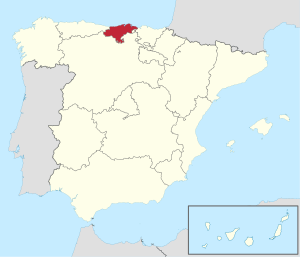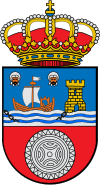Annex: Municipalities of Cantabria
Cantabria is one of the seventeen autonomous communities of Spain and is divided into 102 municipalities, in accordance with the territorial organization included in article 137 of the Spanish Constitution of 1978:
The State is organized territorially in municipalities, provinces and autonomous communities. All these entities enjoy autonomy in the management of their respective interests.Spanish Constitution of 1978, Title VIII, Article 137.
The figure of the municipality is defined in the Law Regulating the Bases of the Local Regime as “the basic local entity of the territorial organization of the state”, with “legal personality and full capacity for the fulfillment of its purposes" and its elements are "the territory, the population and the organization".
The administration and government of the municipality is carried out through a collegiate body called the city council or mayor's office, headed by a one-person institution: the mayor. Until 2011, the municipalities of Tresviso and Pesquera were governed through a type of traditional assembly system called open council, but with the change in law, both abandoned this system to be governed through representation in mayors and councilors.
In general, municipalities have several locations, one of which is the municipal seat, which usually houses the town hall. Some municipalities have the name of one of their localities —whether it is their municipal seat or not— and others do not share a name with any of them. There may also be other infra-municipal government bodies that enjoy a certain degree of management autonomy. These are the so-called minor local entities, which correspond to villages, parishes or districts, whose legal representation resides in their neighborhood council. Each entity has a municipality code made up of five or six numbers; the first two correspond to the code of the province, the next three to that of the municipality within it and the last one is a control digit to detect errors.
It should be noted that the Campoo-Cabuérniga Commonwealth does not constitute per se a municipality, even despite the extension of its territory. It is a large communal property unique due to its size and characteristics, shared management between the municipalities of the Brotherhood of Campoo de Suso, Cabuérniga, Los Tojos and Ruente.
Municipal elections
| 1987 | 1991 | 1995 | 1999 | 2003 | 2007 | 2011 | 2015 | ||
| P 1 | votes | 106 583 | 57 901 | 107 823 | 123 429 | 133 907 | 139 555 | 152 423 | 116 049 |
| councillors | 416 | 227 | 372 | 447 | 424 | 429 | 478 | 433 | |
| PSC-PSOE | votes | 95 171 | 103 873 | 89 772 | 99 135 | 102 973 | 92 425 | 70 882 | 64 498 |
| councillors | 290 | 349 | 282 | 267 | 256 | 245 | 196 | 190 | |
| PRC | votes | 28 227 | 18 966 | 33 221 | 49 898 | 66 592 | 73 783 | 70 634 | 71 952 |
| councillors | 100 | 69 | 88 | 217 | 276 | 302 | 319 | 325 | |
| IU | votes | 12 609 | 13 789 | 23 302 | 11 674 | 13 714 | 5644 | 10 890 | 14 445 |
| councillors | 19 | 16 | 27 | 14 | 15 | 8 | 10 | 15 | |
| CDS | votes | 25 591 | 10 661 | 1126 | 1832 | 747 | - | -- | - |
| councillors | 69 | 30 | 0 | 2 | 0 | - | -- | - | |
| UPCA | votes | - | 71 683 | 41 628 | 9179 | - | - | -- | - |
| councillors | - | 285 | 170 | 29 | - | - | -- | - | |
| UCn | votes | - | - | - | - | 8226 | 460 | -- | - |
| councillors | - | - | - | - | 15 | 1 | -- | - | |
| TOTAL | votes | 298 552 | 294 365 | 312 772 | 307 522 | 336 708 | 347 360 | 346 383 | 331 749 |
| 1 In 1987 it was presented as a Popular Coalition (AP-PDP-UL). | |||||||||
Municipal elections are held on the fourth Sunday of May every four years, coinciding with the regional elections.
The electoral system that they follow is regulated by the Organic Law of the General Electoral Regime (LOREG), and is based on voting through closed lists and the assignment of councilors following the D'Hondt system. The electoral threshold required for each candidacy to obtain representation is 5% of the valid votes cast.
Citizens of the countries of the European Union registered in Cantabria have the right to active and passive suffrage, in accordance with the laws that have been established to comply with European Council Directive 94/80/CE.
Citizens of countries with reciprocity agreements can also vote, including: Argentina, Bolivia, Brazil, Burkina Faso, Cape Verde, Chile, Colombia, South Korea, Ecuador, Iceland, New Zealand, Paraguay, Peru, Trinidad and Tobago, Uruguay, Venezuela. On the other hand, Spanish citizens residing in some non-EU countries such as Norway also enjoy the right to vote, despite the absence of a reciprocity agreement.
The number of councilors per municipality is assigned based on the people registered in it, according to the following relationship:
- Up to 100 inhabitants, 3 councillors.
- 101 to 250, 5 councillors.
- 251 to 1000, 7 councillors.
- From 1001 to 2000, 9 councillors.
- From 2001 to 5000, 11 councillors.
- From 5001 to 10,000, 13 councillors.
- 10 001 to 20 000, 17 councilors.
- From 20 001 to 50 000, 21 councillors.
- 50 001 to 100 000, 25 councillors.
Map
List of municipalities
Contenido relacionado
Alba dry village
Annex: Municipalities of the province of Zamora
Veracruz (disambiguation)













































































































